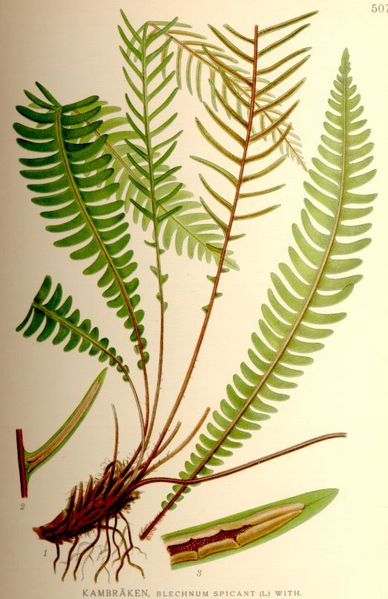
This evergreen perennial fern is native to Europe, northern Asia, Japan and western North America from southern Alaska to the central California coast, mostly west of the Cascades. It belongs to the hard fern or rough spleenwort family, Blechnaceae. The plants grow 1-3′ tall and have a thick, short rhizome that produces dark purplish brown stalks. The fronds are of two types, one fertile, the other sterile. The sterile fronds are 12-24″ tall, dark green, leathery, deeply lobed and spread outward around the central fertile fronds that are 16-24″ tall, erect, and wither and turn brown after spore dispersal. The leaflets on the fertile fronds are narrow and roll around the continuous sori to produce a tube-like appearance. Deer fern is an attractive fern and does well in a variety of conditions so is a good choice for a ground cover, shade garden, woodland garden, and houseplant. It provides winter food for game animals such as deer, moose and elk so is valuable in a wildlife garden. Native Americans have used the plant for traditional medicine. The genus name, Blechnum, is from the Greek word blēchnon , the general term for fern. The specific epithet, spicant, may come from the Latin word spicare, meaning to furnish with spikes, referring to the erect fertile fronds.
Type: Evergreen herbaceous perennial
Bloom: None
Size:1-3′ H x 2′ W
Light: Partial shade to full shade
Soil: Average, consistently moist, well-drained; tolerates very acid soil
Hardiness: Zones 4-8
Care: Low maintenance; remove unattractive fronds as they deteriorate; do NOT apply fertilizer
Pests and Diseases: Generally healthy but susceptible to leaf spot, and rust, and damage by caterpillars, mealybugs and scale.
Propagation: Spores, division in spring or fall
Companion Plants: Alumroot, foam flower, salal, sword fern, trillium, vanilla leaf
Outstanding Selections: Unavailable
Photo Credit: Wikipedia